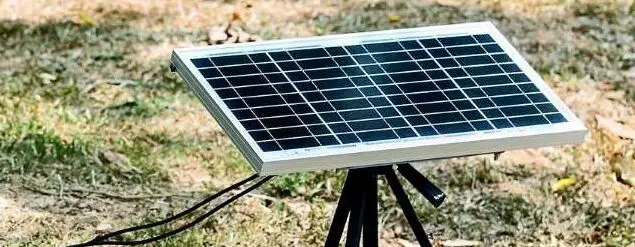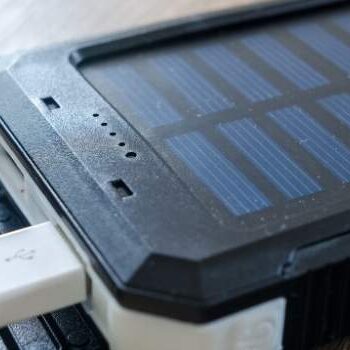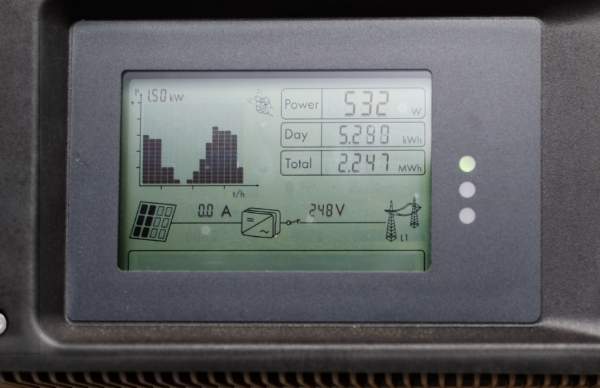
Solar generators are an innovative solution for generating electricity in an eco-friendly manner. These devices harness the power of the sun and convert it into usable electrical energy, providing an alternative to traditional gas-powered generators.
A solar generator is an efficient and portable power system that uses solar energy to generate electricity. Comprised of solar panels, an AC power inverter, and batteries, it serves as a power source in various situations, ranging from outdoor recreational activities to emergency power backup during blackouts.
As solar generators become more prevalent, various types, brands, and performance factors come into play, making it essential for users to understand the benefits and drawbacks associated with these devices.
Key Takeaways
- Solar power generators convert sunlight into electricity, offering a sustainable power solution.
- Components of a solar powered generator include solar panels, batteries, and an inverter.
- Different types, brands, and performance factors cater to diverse user needs and scenarios.
Solar panels are the primary component in a solar powered generator, responsible for converting sunlight into DC (Direct Current) electricity. These panels capture solar energy and utilize photovoltaic cells to generate power. They often require one or more solar panels, depending on their capacity and power needs.
The next essential component is the AC power inverter, which converts the DC electricity produced by solar panels into AC (Alternating Current) electricity. AC electricity is required to power most household appliances and electronic devices. A high-quality inverter ensures efficient and consistent energy conversion, enabling seamless performance of various devices.
Lastly, a solar generator includes a battery storage system that stores the electricity generated by the solar panels for later use. This feature is particularly useful when sunlight is unavailable or during nighttime use. The capacity and battery chemistry (e.g., lithium-ion, lead-acid) may vary, affecting the overall performance, lifespan, and cost of the generator.
Table of Contents
Components of a Solar Generator

Solar Panels
Solar panels are the primary component responsible for converting sunlight into electricity.
These panels are also known as photovoltaic solar panels and are made up of arrays of series and parallel connected solar cells.
The potential difference developed across a solar cell is typically about 0.5 volts, and the desired number of these cells are combined to form a solar panel that can produce a higher voltage. Solar panels come in various types and sizes, providing flexibility based on individual needs.
Battery Bank

The battery bank in a solar generator stores the electricity generated by the solar panels.
The choice of battery type is vital for its efficiency and lifespan. Lithium-ion and Lithium Iron Phosphate (LiFePO4) batteries are two popular options.
Lithium-ion batteries are lightweight and have a high energy density, making them a suitable choice for portable solar powered generators.
However, they tend to have a shorter lifespan compared to LiFePO4 batteries.
LiFePO4 batteries, on the other hand, offer a longer lifespan and better thermal stability, making them a safer and more robust choice for larger solar power generator systems. Both options have their advantages and can be chosen depending on the specific needs and requirements.
Charge Controller
A charge controller plays a crucial role in managing the flow of electricity between the solar panels, battery bank, and inverter.
The primary function of the charge controller is to prevent the batteries from overcharging by regulating the voltage and current generated by the solar panels.
The Maximum Power Point Tracking (MPPT) charge controller is a popular choice due to its ability to optimize the efficiency of the solar panel output. By using an MPPT charge controller, the solar generator system can extract the most power from the solar panels, improving overall performance and lifespan.
Inverter

The inverter is responsible for converting the stored direct current (DC) electricity in the batteries into alternating current (AC) power, which can be used to run appliances and devices.
The inverter’s wattage rating determines how much power it can provide.
Choosing the right inverter with the appropriate wattage rating is essential for ensuring the solar generator can power the intended devices and appliances efficiently.
Types of Solar Generators
Solar generators are devices that convert sunlight into electricity, which is then stored in a battery bank. There are two main types of solar powered generators: Portable Power Stations and Home Backup Systems.
Portable Power Stations
Portable power stations, also known as solar power banks or kits, are lightweight, compact, and easy to transport. They are designed for powering small electronics and appliances, such as smartphones, tablets, laptops, and lights. These generators are perfect for outdoor activities like camping, picnicking, hiking, or emergencies when grid power is unavailable.
Key features of portable power stations include:
- Battery Capacity: Measured in watt-hours (Wh), with a wide range of options to choose from depending on user needs.
- Solar Panel Compatibility: Not all power stations come with solar panels; some may require purchasing separately.
- Output Ports: Includes a variety of ports, such as USB, AC, and DC, to accommodate multiple devices.
- Power Output: Rated in watts (W), which determines the ability to provide power to various appliances.
Home Backup Systems
Home backup systems are stationary solar generators that connect to your home’s electrical grid. They are powerful enough to support major appliances, such as refrigerators, air conditioners, and televisions, during power outages or emergencies. Home backup systems provide a reliable, sustainable, and eco-friendly alternative to traditional generators.
Notable features of home backup systems include:
- Battery Storage: Measured in kilowatt-hours (kWh), these systems have much larger capacities than portable power stations.
- Solar Panel Size: Larger solar panels are required to generate and store sufficient energy for home usage.
- Inverter: A component that converts the stored DC power from the battery into AC power to operate home appliances.
- Grid-Tied or Off-grid: Grid-tied systems synchronize with the electrical grid, allowing surplus energy to be sold back, while off-grid systems operate independently.

Top Solar Generator Brands
Jackery
Jackery is a reputable brand known for its portable solar generators. Two popular models from this manufacturer include the Jackery Explorer 500 and Jackery Explorer 1000.
These portable generators are designed to provide reliable power for a variety of applications, such as camping, emergency situations, and outdoor work. They are durable, lightweight, and have multiple output options for convenient use.
- Explorer 500: 518Wh capacity, 500W continuous output
- Explorer 1000: 1002Wh capacity, 1000W continuous output
Bluetti
One of their most notable products is the Bluetti EP500Pro. This solar generator features a massive lithium iron phosphate (LiFePO4) battery and a strong inverter, making it an excellent choice for those in need of significant power storage and output. Bluetti generators are praised for their impressive performance and quality construction.
Goal Zero Yeti
The Goal Zero Yeti 1500X is a popular model of solar powered generator boasting a 1516Wh capacity and a high-quality inverter. Designed for efficiency and versatility, the Yeti 1500X can power multiple devices simultaneously and offers numerous charging options, making it ideal for off-grid living, emergency preparedness, and outdoor adventures.
BioLite
BioLite is an innovative brand specializing in energy products for off-grid living and emergency situations. Their BaseCharge 1500 solar powered generator is designed for efficient energy storage and output, featuring a compact design, multiple charging options, and an integrated solar charge controller.
Charging and Power Output Options
AC Outlets
Solar generators typically come equipped with one or multiple AC outlets, allowing users to power various appliances and devices that require alternating current electricity.
The power output capacity of AC outlets on solar powered generators varies based on the size and model, but commonly falls within the range of 300W to 2000W. It is essential to check the total wattage of the devices being connected to ensure seamless operation and prevent overloading the generator.
DC Output Ports
In addition to AC outlets, solar power generators offer DC output ports for charging or powering devices that run on direct current electricity.
These ports provide a more energy-efficient option for devices with lower power needs, such as LED lights, portable fans, and small electronics. The selection of DC power output ports on a generator may include standard barrel-type connectors and 12V car sockets.
USB-A and USB-C Ports
To accommodate the ever-growing range of electronic devices, solar generators often feature multiple USB charging ports, both USB-A and USB-C types.
USB-A ports are distinguished by their rectangular shape, whereas USB-C ports showcase a smaller, reversible design. These ports allow users to charge devices like smartphones, tablets, and other USB-compatible gadgets directly from the solar powered generator.
When selecting a solar generator with USB ports, consider the power output capability of each port to ensure efficient and rapid charging.
Some models offer USB ports with fast-charging capability, while others may have lower charging speeds. Remember that the number of devices connected simultaneously may affect the overall charging time and efficiency.
Usage Scenarios
Camping and Outdoor Activities
Portable solar generators provide a renewable source of energy, perfect for powering devices such as smartphones, cameras, and small appliances during outdoor adventures. The lightweight and compact design of these generators make them easy to transport and set up in off-grid locations.
- Portable Power: Solar powered generators with different wattages are available, catering to specific needs of campers and outdoor enthusiasts.
- AC and DC Outlets: Many solar powered generators offer a mix of AC and DC outputs, allowing a wide range of devices to be connected.
Power Outages and Emergency Backup
In times of crisis, a solar powered generator can help supply power for essential household appliances and devices, ensuring comfort and safety for you and your family.
- Backup Power: Solar generators act as a reliable power source during emergencies when grid power is unavailable.
- Emergency Situations: A solar generator can power essential devices, such as medical equipment, communications tools, and lights, during natural disasters or power outages.
Off-Grid Living
Solar generators are an excellent power solution for individuals and families living off the grid. These generators offer an environmentally-friendly and reliable electricity source, which can be used to power home appliances, power tools, and more.
- Off-Grid Essentials: Solar generators can efficiently power several home appliances, like refrigerators and air conditioners, contributing to a comfortable off-grid lifestyle.
- Rechargeable: A solar generator like Goal Zero Yeti 1500X can be efficiently recharged with solar panels, making it ideal for off-grid locations.
Performance Factors and Considerations
Watt-Hours and Battery Life
Solar generators are equipped with battery banks that store the electricity generated from sunlight through photovoltaic panels.
These batteries are rated in watt-hours, which indicates the amount of power that the generator can store. Battery life is an essential factor to consider as it determines the duration for which the generator can run small appliances and devices. Higher watt-hour ratings provide longer runtimes, allowing for more extended usage.
Charging Times
Charging times can vary depending on the size and efficiency of the solar panels, as well as the amount of sunlight the panels receive. Remember to choose a solar powered generator with an optimal charging time for your needs, ensuring that you have a reliable power source when needed.
Size and Durability
A compact and lightweight design makes the generator easy to transport and handle, which can be especially beneficial for outdoor activities and emergencies.
However, a durable and robust construction is essential to withstand harsh conditions and ensure a long-lasting, dependable power source.
Noise Levels
Many users appreciate solar generators for their silent operation, resulting from using photovoltaic panels instead of fossil fuels to generate electricity.
Unlike traditional generators that create noise from combustion engines, solar power generators typically produce minimal to no noise during operation. This feature makes solar powered generators an excellent choice for users who prioritize a quiet and non-disruptive environment.
Benefits and Drawbacks
Solar generators hold a potent position in the renewable energy sector, offering an eco-friendly and adaptable alternative to traditional gas-powered generators. Understanding their advantages and disadvantages can help users better decide their utility within various applications.
Benefits:
- Renewable Energy Source: As solar generators harness energy directly from the sun, they utilize an unlimited and clean source of power, reducing the dependency on fossil fuels. This makes them a sustainable choice for power supply.
- No Emissions: They produce electricity without emitting harmful greenhouse gases, thus causing no air or noise pollution. This environmentally friendly nature makes solar generators perfect for residential and outdoor use.
- Quiet Operation: Most models operate silently, which is a significant advantage over loud gas generators. This makes solar generators suitable for use in quiet environments like homes, offices, and campsites.
- Low Maintenance: With fewer moving parts than traditional generators, solar generators require less maintenance, which can lead to reduced expenses and increased reliability.
Drawbacks:
- Intermittent Power Generation: Solar generators depend on sunlight to generate power, and efficiency can decrease during cloudy or rainy days, or at night. This unpredictability may necessitate battery storage or a backup generator to ensure uninterrupted power supply.
- Initial Cost: Although solar powered generators have low operating costs, the initial investment in the equipment, such as solar panels, batteries, and inverters, can be higher compared to a traditional generator. However, this can be offset by long-term savings on fuel and maintenance.
- Space Requirements: Solar generators require adequate space for solar panel installation. This can be a concern for urban dwellers or in areas with limited space.
- Not Suitable for High-Powered Applications: Solar powered generators may not be able to handle energy-intensive equipment such as heavy machinery or large appliances. In such cases, traditional generators or a combination of multiple solar panels could be necessary.
Frequently Asked Questions
How Does a Solar Generator Function?
A solar generator functions as an integrated portable power source that receives power from solar panels, an AC outlet, or a DC power source such as a car battery, and stores that energy in an onboard battery bank. It is a portable battery storage system powered by solar panels.
Which Solar Generators Are Best for Home Backup?
To determine the best solar generator for home backup, it is essential to compare factors like watts, watt-hours, battery chemistries, and the appliances you want to back up. Solar generators are not designed to back up major appliances in the event of an outage, so choosing a suitable solar generator depends on your specific needs and requirements.
Can a Solar Generator Power an Entire House?
Solar generators are not typically designed to power an entire house. Their primary function is to serve as a portable source of electricity for smaller devices and appliances. For powering an entire house, a more extensive solar-plus-storage system would be necessary.
How Long Can a Solar Generator Typically Run?
The runtime of a solar generator depends on factors like its battery capacity, the power requirements of the devices being used, and the availability of sunlight to recharge the battery. As long as there is daylight, a solar generator can harness renewable energy for use. However, its actual runtime will vary based on the specific generator and usage conditions.
